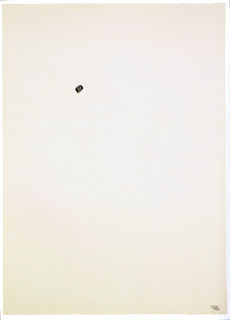I recently got from the library the book Hard Pressed: 600 Years of Prints and Process, which is the companion book to a 2000 exhibition. I found lots of interesting information on the history of various print media, and I enjoyed looking through all the illustrations… but I have to confess that I was disappointed in the prints representing the last fifty years or so.
The curators, Elizabeth Wyckoff and David Platzker, chose a selection of pieces that seemed to me, with a few exceptions, a boring and pointless wasteland. Obviously this reflects my taste and theirs as well as the state of what artists are actually out there making. It also reflects the exhibition's stated intention of examining "the effects of technical advances in the history of printmaking." This meant that there was a preponderance of processes such as offset lithography and Iris prints, which, roughly speaking, are fancy methods of xeroxing. That gives the impression that the Art World (as represented by the authors) has no more interest in artists who actually craft their own work by hand. I find this rather depressing. (It also brings up some interesting questions about the concept of "hand-made" and "limited edition," which I'd better save for another post.) Moreover, the emphasis was on "conceptual" art, with no apparent interest in the skill or mastery of materials, and no apparent interest in creating a thing of beauty, as opposed to making a point. Often the point that was made seemed to be simply how little work a big-name artist can get away with.
The book's introduction is an excellent explanation of how the curators see the progress of printmaking, and it definitely clarifies and justifies the reasoning behind their choices. (I recommend reading it if you struggle with some of these ideas about art, as I do.) Nevertheless, while I totally endorse "because I wanted to see if I could" as a valuable exercise for artists to engage in, I can't seem to accept it as sufficient to qualify an object as actually being a piece of art.
Does xeroxing a single word on the cover of a pamphlet, for example, constitute art? That is, of course, a matter of opinion, and I've hereby betrayed my opinions on certain schools of modern art above and beyond printmaking. People have made such complaints about "modern art" for the past two hundred years, so perhaps only time will tell which pieces can achieve an enduring resonance with viewers. Perhaps I will turn out to be one of those benighted stick-in-the-muds like those who denounced Impressionism. On the other hand, my hope is that there will always be a place for artists who practice and demonstrate incredible skill in the making of original, hand-crafted, unique images that draw the viewer in and open us to seeing the world in new ways. Sometimes it seems that such artists don't get much respect in the Art World. I can't help anyone with that, but at the very least I can celebrate original, hand-crafted, beautiful art here.
[Pictures: THUMBPRINT, lithograph by Bruce Conner, 1965 (Photo from the University of New Mexico Art Museum);
Statements, offset lithography with glued binding, conceived by Lawrence Weiner, 1968.]
Hard Pressed: 600 Years of Prints and Process, by David Platzker and Elizabeth Wyckoff, Hudson Hills Press, 2000.



Good grief! Thanks for saying out loud (well, in print) what I and others have been thinking.
ReplyDelete